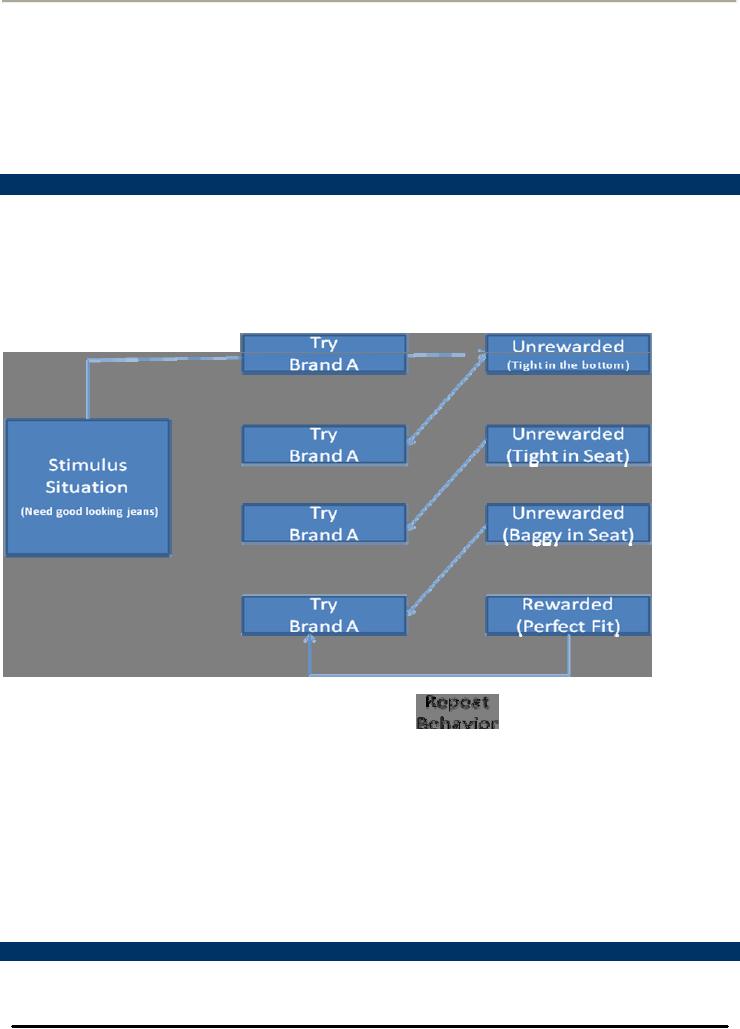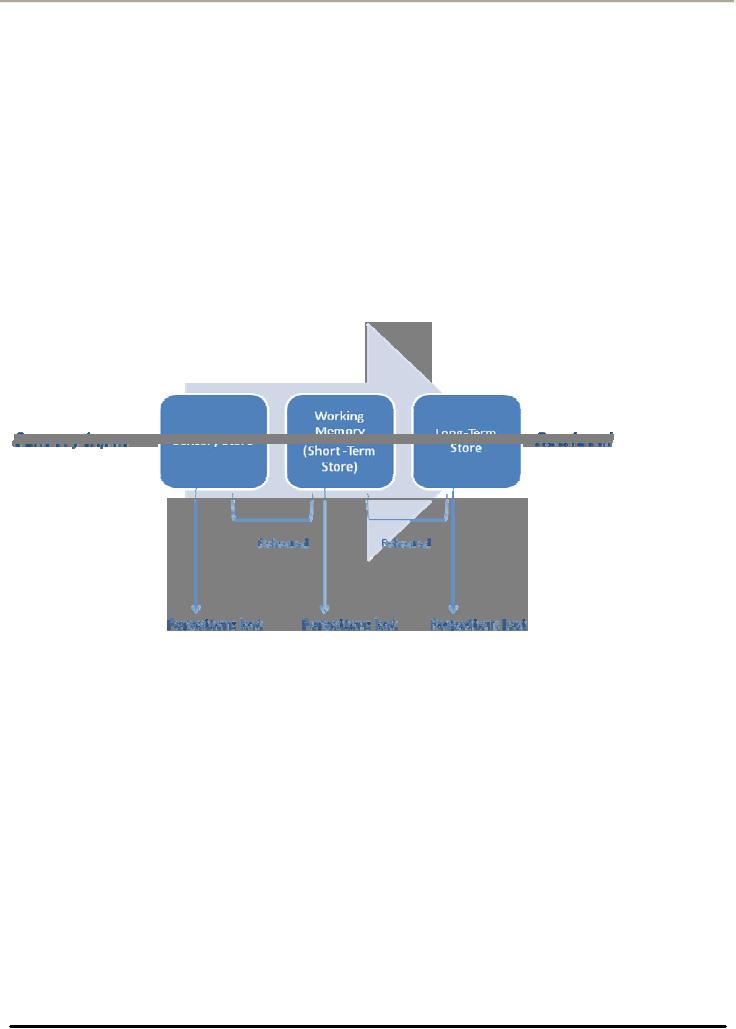 |

Consumer
Psychology (PSY -
514)
VU
LESSON32
INSTRUMENTAL
CONDITIONING, INFORMATION PROCESSING AND
MEMORY
CHAPTER
5: INDIVIDUAL DETERMINANTS OF CONSUMER
BEHAVIOR
Understanding:
�
Instrumental
Conditioning
�
Information
processing and memory
Instrumental
(Operant) Conditioning
Instrumental
Conditioning theorists hold
that stimulus that is linked
to the most satisfactory response
will be
learnt.
They believe that learning
occurs through a trial and
error process with habits
formed as a result of
rewards
received
for certain responses or
behaviors. B.F.Skinner (a learning theorist) believed
that most learning
takes
place
in a controlled environment in which
individuals are "rewarded"
for choosing an appropriate
behavior.
Instrumental
Conditioning at a Glance
Reinforcem
ent
of Behavior
Two
types of Behavior reinforcements are
discriminated in Instrumental
Conditioning:
Positive
Reinforcement
Consists
of the events that increase the
likelihood of a specific response. An
individual may purchase
cosmetics to
achieve
a desired impact in physical
appearance.
Negative
Reinforcement
An
unpleasant or negative outcome
that serves to encourage a
specific behavior. An individual
may purchase Life
insurance
policy to avoid mishaps in the
future.
2.
Information Processing and
Memory
Cognitive
Learning Theory
106

Consumer
Psychology (PSY -
514)
VU
Learning
based on mental activity is
called Cognitive Learning. Human
beings learn through problem
solving
which
enables individuals to gain
some control over their
environment. Learning involves complex
mental
processing
of information.
Information
Processing
Information
processing relates to consumer's
cognitive ability and
complexity of information. Consumers
process
product
information related in terms of a
product's attributes, brand, comparisons between
brands and a
Combination
of these factors.
The
more experience a consumer
has with a product category,
the greater his/her ability to
make use of product
information.
Greater familiarity with product
also increases cognitive
ability and learning during a
new purchase
decision,
particularly with regards to technical
information
A
research study found that
people exert huge cognitive efforts in
processing information about
products. They
sometimes
experience a process induced
negative effect toward alternatives. So
they are more likely to
choose a
product
that required less effort to
evaluate. The negative effect, however,
did not influence product
choice for a
clearly
superior product
Imagery
Imagery
is ability to form mental
images. Individual differences in
imagery may measured with
the help of specific
tests.
Some of these tests
are:
Imagery
Vividness
Processing
Style
Daydream
(fantasy) content and
frequency
Learning
by Analogy
Some
consumers learn by analogy. They
transfer the knowledge about products
they are familiar with to
new or
unfamiliar
products in order to enhance their
understanding.
How
Consumers Store, Retain, and Retrieve
Information
It
is important for Cognitive
Psychologists to understand how people
store, retain and retrieve
information.
Following
concepts are used to
understand the information
processing:
Sensory
Store
Short
Term Store
Long
Term Store
1.
Sensory Store
All
data comes to us through our
five senses. Senses do not
transmit whole images. Each
sense receives a
fragmented
piece of information and
transmits it to the brain. In brain
perceptions of a single instant
are
synchronized
and perceived as single
image in a single moment of time. The
image of a sensory input
just lasts for
a
second or two in the mind's sensory
store. If it is not stored it is lost
forever.
Implications
for Marketers
We
are constantly bombarded with stimuli
from the environment and we
subconsciously block a lot
of
information
that we don't need or cannot
use. For marketers it means
that although it is relatively easy to
get
information
into the consumer's sensory
store it is difficult to make a
lasting impression
Brain
automatically and subconsciously tags
all perceptions with a value
either "positive" or "negative".
This
evaluation
added to the initial perception in the
first micro second of cognition
tends to remain unless
further
information
is processed. This would explain
why our first impressions
tend to last and why it is
hazardous for a
marketer
to introduce a product prematurely into
the market
2.
Short term Store
107

Consumer
Psychology (PSY -
514)
VU
Short
Term Store is known as
working memory. The stage of
real memory in which the
information is processed
and
held just for a brief period
of time. Information in the short term store
undergoes the process of
rehearsal.
Rehearsal
is the silent
mental repetition of the information. It
is then referred to the long term
store.
The
transfer from short term to long term
store takes about 2-10
seconds. If the information is not
stored or
rehearsed
it is lost in about 30 seconds or less.
The amount of information that
can be held in short term storage
is
limited
to about 4 or 5 items.
3.
Long Term Store
Long-term
store retains information
for relatively extended periods of time.
It is possible to forget
something
within
a few minutes after the information
has reached in the long term
store. It is more common for
data in long
term
storage to last for days,
weeks, months or even years.
Almost all of us can
remember the name of our
first
grade
teacher.
Information
Processing through memory
Stores
Rehearsal:
The
amount of information available from
Short Term and Long Term
Memory Storage depends upon
how
much
rehearsal it is given. Rehearsal is done by
repeating the information or associating
it with something
else.
Information
can also be lost because of
competition for attention. If the short
term store receives a great
number
of
inputs simultaneously from the sensory
store its capacity may be
reduced to only 2 or 3 pieces of
information.
Encoding
Encoding
is the process by which we select a word
or a visual image to present a
perceived object. Marketers help
consumers
encode brands by using brand
symbols such as role model
cricketers or cartoons.
Retention
Information
does not just sit in the
long term memory store
waiting to be retrieved. Information is
constantly
organized
and reorganized as new links
between chunks of information
are forged.
Information
Overload
108

Consumer
Psychology (PSY -
514)
VU
When
the consumers are presented
with too much information
this is called Information Overload.
Consumers
may
encounter difficulty in encoding and storing it all.
Consumers can become
cognitively overloaded when they
are
given too much information in a short
span of time.
Activation
Information
processing theorists believe
that long term memory store
is a network consisting of nodes
(concepts)
with
links between and among
them. As individuals gain
more knowledge about a subject they
expand their
network
of relationships and sometimes seek
more information. This
process is known as activation.
Consumers'
memory
for the name of a product
may also be activated by relating it to
the spokesperson used in its
advertising.
The
total package of associations
brought to mind when a cue is
activated is called a
schema.
Retrieval
Retrieval
is the process by which we recover
information from the long term
storage. When we are unable
to
remember
something with which we are
familiar we are experiencing a
failure of retrieval system.
Marketers
maintain that consumers tend to
remember the products benefits than its
attributes. Advertising
messages
are mot effective when they link the
product's attributes with the benefits that
consumers seek from
the
product.
Interference
Effect
The
greater the number of competitive ads in
a product category, the lower the
recall of brand claims in a
specific
advertisement.
This is called interference effect.
Interference effects are
caused by confusions by competing
ads
and
make retrieval difficult. Ads
can also act as retrieval
cues for competitive brands.
Advertising that creates
a
distinct
image can assist in
retention and retrieval of message
contents
109
Table of Contents:
- INTRODUCTION TO CONSUMER PSYCHOLOGY:Consumer Behavior
- INTRODUCTION TO CONSUMER PSYCHOLOGY:Consumer research
- INTRODUCTION TO CONSUMER PSYCHOLOGY:Marketing Mix, Product, Price
- INTRODUCTION TO CONSUMER PSYCHOLOGY:Customer Value, Perceived Value
- VALUE AND RETENTION FOCUSED MARKETING AND CONSUMER DECISION MAKING PROCESS
- CONSUMER RESEARCH:Quantitative Research, Qualitative Research
- MAJOR STEPS IN CONSUMER RESEARCH PROCESS:Design of Primary research
- QUANTITATIVE RESEARCH DESIGNS & DATA COLLECTION METHODS
- QUANTITATIVE RESEARCH DATA COLLECTION TECHNIQUES:ATTITUDE SCALES
- QUALITATIVE RESEARCH DESIGNS & DATA COLLECTION METHODS
- CUSTOMER SATISFACTION MEASUREMENT, SAMPLING, AND DATA ANALYSIS AND REPORTING
- MARKET SEGMENTATION AND ITS BASES:Geographical Segmentation
- BASES FOR SEGMENTATION: DEMOGRAPHIC SEGMENTATION PSYCHOGRAPHIC SEGMENTATION
- BASES FOR SEGMENTATION: SOCIOCULTURAL SEGMENTATION USE RELATED SEGMENTATION USAGE SITUATION SEGMENTATION
- BASES FOR SEGMENTATION: BENEFIT SEGMENTATION:Intrinsic Cues
- BASES FOR SEGMENTATION: HYBRID SEGMENTATION STRATEGIES
- MARKET SEGMENTATION IMPLEMENTING SEGMENTATION STRATEGIES ENVIRONMENTAL INFLUENCES CULTURE
- HOW CULTURE IS LEARNT ENVIRONMENTAL INFLUENCES:Formal Learning
- CULTURE AND ITS MEASUREMENT ENVIRONMENTAL INFLUENCES
- MEASUREMENT OF CULTURE ENVIRONMENTAL INFLUENCES:Consumer Fieldwork
- SUBCULTURE CHAPTER 4: ENVIRONMENTAL INFLUENCES
- AGE AND GENDER SUBCULTURE CHAPTER 4: ENVIRONMENTAL INFLUENCES
- BASES FOR SEGMENTATION: BENEFIT SEGMENTATION:Market Segmentation
- SOCIAL CLASS CHAPTER 4: ENVIRONMENTAL INFLUENCES:Occupation
- CONSUMER SOCIAL CLASSES CHAPTER 4: ENVIRONMENTAL INFLUENCES:Affluent Consumer
- CONSUMER SOCIAL CLASSES CHAPTER 4: ENVIRONMENTAL INFLUENCES:Membership Group
- CONSUMER SOCIAL CLASSES CHAPTER 4: ENVIRONMENTAL INFLUENCES:Shopping Groups
- UNDERSTANDING PERSONALITY CHAPTER 5: INDIVIDUAL DETERMINANTS OF CONSUMER BEHAVIOR
- CONSUMER PERSONALITY, TRAIT THEORY AND SELF IMAGES
- CONSUMER MOTIVATION:Needs, Goals, Generic Goals
- UNDERSTANDING LEARNING:Intentional and Incidental Learning, Implications for Marketers
- INSTRUMENTAL CONDITIONING, INFORMATION PROCESSING AND MEMORY
- ATTITUDES:Characteristics of Attitudes, Attitudes have consistency
- ATTITUDE FORMATION AND CHANGE:How attitudes are learned?
- ATTITUDE CHANGE STRATEGIES:Resolving two conflicting attitudes
- INTRODUCTION TO CONSUMER DECISION MAKING:Decision Complexity
- Problem Recognition, Search and Evaluation and Decision and Purchase
- Decision and Purchase:Consumer Decision Rules, Output, Relationship Marketing
- Decisions Related to Post Purchase:Product Set up and Use
- Marketing Implications of Decisions Related to Post Purchase:Understanding
- Post Purchase Evaluation:Determinants of Satisfaction, Consumer Complaint Behavior
- Post Purchase Dissonance:Dissonance Reduction, Marketing Implications
- Consumerism:Roots of Consumerism, The Nature of Consumerism
- Consumerism – Issues and Responses:Environmental Concerns, Consumer Privacy
- Review – Consumer Psychology Course:Consumer Research, Consumerism